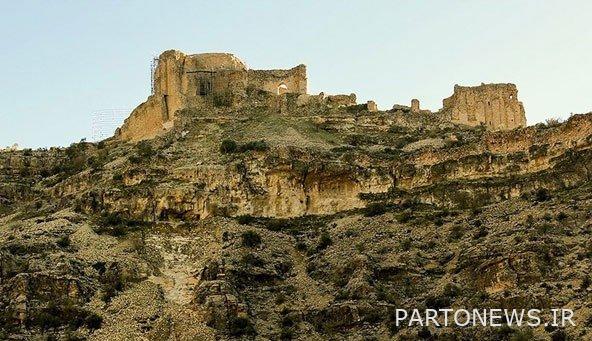“Bashkurtaran” an unknown fortress with Sassanid traces

The historical fortress of “Bashqortaran” or “Qaz Qala Si” is located at a distance of 1.5 km south of Bashqortaran village, on top of a mountain, which can be accessed after taking a Malraux route with a steep slope. This castle is located in Bashqortaran village in Shirinso section of Kabudrahang county and in the northernmost point of Hamadan province.
Bashkortaran is the northernmost village of the province and has potential in the field of tourism, including the aforementioned castle. Two other lordly castles named Hadi Khan and Fathi Sultan are also located in the village, and the stone bath of Bashkortoran is another historical monument of the village.
The first and only season of exploration of Bashkortoran Castle was conducted in 1391 under the supervision of Dr. Ismail Rahmani, and after that the castle has been left as it is. In order to learn about the condition of the building and information about the excavation, we sat down to talk with this archaeologist.
Rahmani told ISNA reporter: So far, only one season of excavation has been done in the castle, and according to the pottery data that was discovered from the site, it is related to the period of the Islamic middle ages, which includes the Seljuk period to the Ilkhanid period.
Pointing out that the castle is located in a mountainous area and is one of the defense and military buildings, he clarified: Bashkortoran Castle includes a tower and a rampart, and inside it there are buildings that, during the exploration, some of them such as a reservoir and a part that The title of the reception room was discovered.
Stating that the buildings are suitable for the type of military spaces and small fortifications, this archaeologist said: There were also pottery workshops in the castle, which showed that it was a supplier of the castle’s basic needs.
Rahmani pointed out that access to additional information about the castle requires more explorations, and said: There are buildings inside the castle that were made into mounds, and in order to determine their use and more information about the buildings, they should be explored so that the architectural spaces are visible. become
Stating that there may be Sassanid foundations in the building, he said: In order to answer this question, the following chapters of the castle must be explored in order to be able to give a firm opinion, but what has been ascertained so far dates back to the early Islamic period and the Middle Ages. Islam is coming back.
Head of Cultural Heritage, Tourism and Handicrafts of Kabudrahang city, in an interview with ISNA, pointing out that this castle is located in Shirinsu district and in a village of the same name, said: Bashqortaran Castle is on top of the mountain and inside the village there are two castles of Arbabi and Hammam. There is also a stone of Bashkortostan.
Mehdi Gholami stated that the strategic reasons and proximity to the Zanjan Plain are among the factors of the formation of the castle, and stated: Based on the pottery data obtained from the excavation, its date goes back to the middle Islamic period.
Pointing out that the castle had a surveillance and military function, he clarified: This castle was one of the most important Islamic cultural settlements in the middle Islamic period, which played a role as a link between Hamedan and Zanjan plains.
Gholami stated that the way the castle was built on top of the highest elevation in the region shows the strategic importance and cultural, economic and political exchanges, and added: The castle is built in the form of a building with an irregular plan on natural stone rocks, which is 98 meters long, 65 meters wide, and the walls are high. It is also four and a half meters.
Pointing out that the materials used in the building are natural stone slabs, he said: The use of Saroj mortar is also seen in the architecture of the castle, in addition, bricks are used in small sizes in some parts.
Head of Cultural Heritage, Tourism and Handicrafts Kabudrahang continued: The building was built with defensive fences and with a structure like military defensive forts overlooking all the surrounding areas and it is difficult to access. It’s amazing.
Gholami stated that according to the way of construction, it seems that the original foundation of the castle was built by the Sassanids and later rebuilt by the Ismailis, and stated that during the excavation operation, several architectural spaces such as water storage and small and large ovens were found in the castle. They are located in the vicinity.
Pointing out that these architectural structures tell that the needs of the castle have been met there, he said: The castle has always been exposed to wind and rain due to its location, and for this reason, it has faced destruction over the years.
In the end, Gholami stated: Most of the pottery obtained from the castle is single-color turquoise glazed pottery, underglaze painting and sprinkled glaze, which usually belong to the 4th to 7th centuries of the lunar calendar.
According to ISNA, military castles with defensive and strong fences are among the architectural buildings that were built in periods of Iran’s history and had a defensive function. Bashkortoran Castle is one of these buildings which, despite its great importance, is unknown and its unknowns will be revealed only with further explorations.


